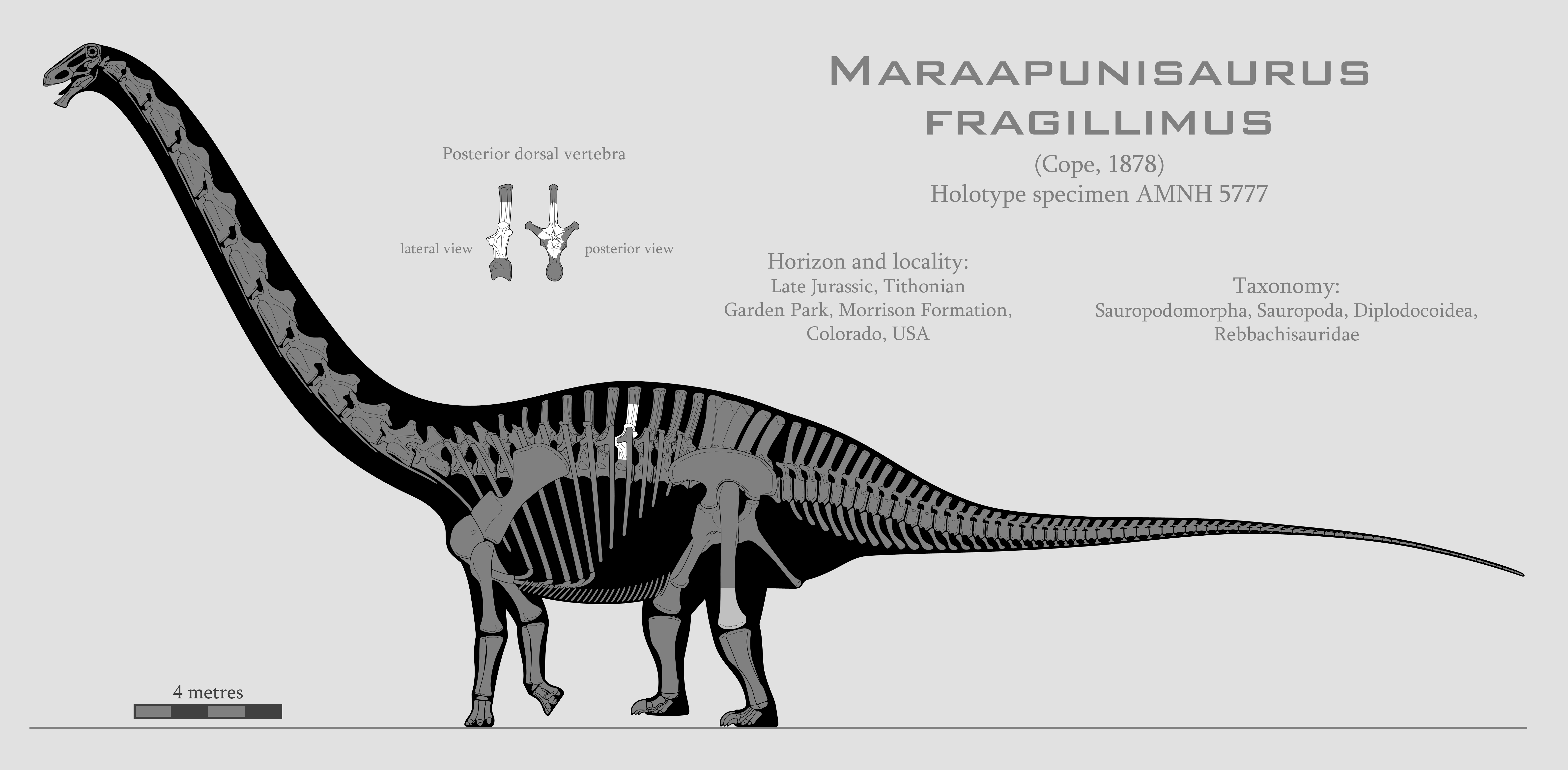Maraapunisaurus fragillimus (“Fragile huge reptile”, “maraapuni” being Southern Ute for “huge”), formerly “Amphicoelias fragillimus” (“Fragile double hollow”), was a gigantic gigapod, or very large sauropod, that lived on North America during the Late Jurassic. It is possibly among the largest land animals to have ever walked the Earth. It is known from a neural arch measuring 1.5 metres tall as preserved, catalogued AMNH 5777, and a possible distal end of a femur. Along with the Barosaurus sp. cervical BYU 9024 and the “Brachiosaurus” nougaredi sacrum specimens, this was likely among the largest dinosaur individuals known from skeletal remains ever to be discovered. The neural arch was badly weakened and crumbling and was soon discarded, probably by Cope himself, but a detailed drawing and descriptions of the specimen survived. The whereabouts of the possible femoral element remain unknown, and it remains without documentation as far, only being mentioned in Cope’s field notes.
Formerly considered to be a diplodocid, a 2018 analysis of its descriptions and the anatomical characters visible in Cope’s original drawing indicate a basal rebbachisaurid affinity. That does NOT necessarily mean it looked like Limaysaurus, however.
Restored based on Haplocanthosaurus, Lavocatisaurus, and a bit of Limaysaurus (dorsal neural spine height). Neck is scaled allometrically.
See the full article here.
Reconstructed dimensions
- Hip height: ~7.5 metres
- Back height: ~9.3 metres
- Shoulder height: ~7.62 metres
- Total height: ~18.39 metres
- Standing length: ~39.86 metres
- Axial length: ~45.7 metres
References
- Osborn & Mook, 1921, “Camarasaurus, Amphicoelias, and other sauropods of Cope”
- Carpenter, 2006, “Biggest of the big: a critical re-evaluation of the mega-sauropod Amphicoelias fragillimus”
- Carpenter, 2018, “Maraapunisaurus fragillimus, N.G. (formerly Amphicoelias fragillimus), a basal rebbachisaurid from the Morrison Formation (Upper Jurassic) of Colorado”
- Hatcher, 1903, “Osteology of Haplocanthosaurus, with description of a new species, and remarks on the probable habits of the Sauropoda and the age and origin of the Atlantosaurus beds”
- McIntosh & Williams, 1988, “A new species of sauropod dinosaur, Haplocanthosaurus delfsi sp. nov., from the Upper Jurassic Morrison Fm. of Colorado”
- Calvo & Salgado, 1995, “Rebbachisaurus tessonei sp. nov. a new Sauropoda from the Albian-Cenomanian of Argentina; new evidence on the origin of the Diplodocidae”
- Carvalho et al., 2003, “Amazonsaurus maranhensis gen. et sp. nov. (Sauropoda, Diplodocoidea) from the Lower Cretaceous (Aptian–Albian) of Brazil”
- Parrish & Michael, 2006, “The origins of high browsing and the effects of phylogeny and scaling on neck length in Sauropodomorpha”
- Canudo et al., 2018, “A new rebbachisaurid sauropod from the Aptian-Albian, Lower Cretaceous Rayoso Formation, Neuquen, Argentina”
Published: February 26, 2019
Last update: April 26, 2020
